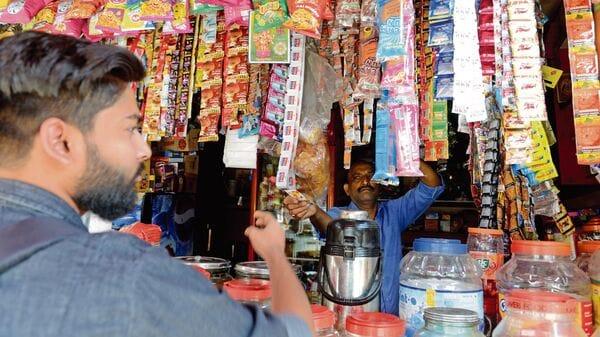To Curb Smokeless Tobacco Use, India Targets 100 High-Burden Districts For Action
Apart from the smoke-emitting products such as cigarettes and beedis, tobacco is widely used consumed in smokeless forms that are chewed, sniffed, or applied to the gums.
Epicenters of crisisThe flagged 100 high-risk districts, identified by the National Institute of Cancer Prevention and Research (NICPR) through a comprehensive analysis of the National Family Health Survey-5 (2019-2021) data, are the epicenters of the nation's tobacco crisis.
According to the report, the states with the highest number of such districts include Madhya Pradesh (15), Odisha (14), Bihar (11), Uttar Pradesh (11), and Gujarat (10). This approach is designed to achieve maximum impact with concentrated resources, ensuring that efforts are directed where they are most needed.
Also Read | Govt proposes stricter tobacco regulations for online content platformsMathematical modeling by the ICMR indicates that a 30% reduction in smokeless tobacco consumption within these 100 districts alone could lead to a nationwide drop to 22.8% from 27.4%. This scientific precision is a hallmark of the new strategy, officials said.
“Our study has identified the precise epicenters of India's tobacco crisis," said Dr Prashant Kumar Singh, senior scientist at ICMR-NICPR. "Five states contribute 61 out of 100 high-burden districts. Madhya Pradesh leads with 15 districts, showing 67.5% to 50.9% prevalence, followed by Odisha with 14 districts. This concentration allows us to deploy resources with surgical precision for maximum national impact."
Dr Singh said the government of Gujarat has already started taking action on the recommendations of the report, a sign of its potential for real-world application.“We are shortly going to submit our report before the health ministry, based on the national consultation meeting which was held last month in Delhi” he said, indicating that broader policy changes are imminent.
Multi-sectoral collaborationThe strategy represents a multi-sectoral collaboration.“We're not just treating tobacco use as a health problem. The report is addressing it as a complex social challenge requiring legal enforcement, community action, healthcare integration, and evidence-based policymaking," said Dr Shalini Singh, director of NICPR. "The identification of 100 specific districts gives us surgical precision in our national tobacco control efforts.”
Apart from regulatory action, legal enforcement and healthcare directives, there is a focus on community-led nudges and corporate accountability to deliver a concentrated push against smokeless tobacco.
To begin with, the plan calls for the setting up of dedicated enforcement task forces in these high-burden districts. These teams will receive specialized training in tobacco control laws, including the Food Safety and Standards Act (FSSA) and the Juvenile Justice Act. Their duties will also include enforcing advertising bans and sales restrictions, particularly near educational institutions, to protect young people from the dangers of tobacco. However, the report does not touch upon any curbs on surrogate endorsements for these products.
Also Read | NMC asks medical institutions to establish dedicated Tobacco Cessation CentresThe report also makes several key recommendations to achieve its goals and calls for the development of district-specific action plans with measurable targets and clear implementation timelines.
It suggests integrating the action against smokeless tobacco directly into primary healthcare, particularly in the high-prevalence areas. With an aim to nudge the tobacco users to give it up, the report recommends launching community-led advocacy campaigns that utilize peer education models and trusted community influencers to spread awareness.
Extending responsibilityThe plan also calls for implementing extended producer responsibility (EPR) frameworks to compel smokeless tobacco companies to fund the cleanup and disposal of their product waste.
This widespread use of smokeless tobacco contributes to a staggering 383,248 deaths in India annually, of which 237,077 were males. Consumption of smokeless tobacco is a major cause of cancer, coronary heart disease, and chronic obstructive pulmonary disease.
"The evidence is clear, the targets are defined, and the pathways are mapped," the report by the cancer prevention research unit said.
Legal Disclaimer:
MENAFN provides the
information “as is” without warranty of any kind. We do not accept
any responsibility or liability for the accuracy, content, images,
videos, licenses, completeness, legality, or reliability of the information
contained in this article. If you have any complaints or copyright
issues related to this article, kindly contact the provider above.
Most popular stories
Market Research

- Poppy Seed Market Size, Share, In-Depth Insights, Opportunity And Forecast 2025-2033
- Daytrading Publishes New Study On The Dangers Of AI Tools Used By Traders
- Origin Summit Debuts In Seoul During KBW As Flagship Gathering On IP, AI, And The Next Era Of Blockchain-Enabled Real-World Assets
- Chicago Clearing Corporation And Taxtec Announce Strategic Partnership
- Bitmex And Tradingview Announce Trading Campaign, Offering 100,000 USDT In Rewards And More
- ROVR Releases Open Dataset To Power The Future Of Spatial AI, Robotics, And Autonomous Systems






















Comments
No comment